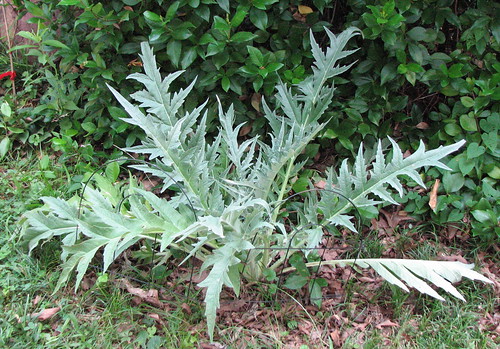How to Grow Globe Artichokes in the Southeast
This is a vegetable I am still experimenting with to get a formula that really works, but I thought I’d share my observations so far.
Out of growing them collectively (but not consecutively) for about 5 years, I’ve harvested artichokes in two different seasons. One year they were nicely sized and tasty, the other year they were a little small but still good.
The key to success seems to be full sun, deep friable soil that drains well, and consistent water. Somewhat finicky, artichokes do not like heavy soil, drought, or soggy feet. Fortunately, their bold silver foliage is quite pretty, so you can also enjoy them as an ornamental while you are testing them in your garden.
They also need a good microclimate to ride out the winter. Alternately, you can grow them as an annual (with 100 frost free days) or protect them with heavy mulch or a polytunnel. Make sure your mulch drains well or the soil will become waterlogged and kill the overwintering roots. A 2′ tall wire cage of loose leaves works well as an insulating mulch. Happily, leaves are available in the fall right when we need them!
If you want to grow them as an annual, purchase seeds or transplants for the variety ‘Imperial Star’ and have them ready to set out about a week before your frost-free date. Protect them from actual frost, but the cool temperatures will trick them into thinking they are a 2 year old plant and causes them to set buds that season (the artichokes we harvest are unopened flowers).
Other varieties I have grown include ‘Green Globe Improved’, ‘Violetto’, ‘Grosso Romanesco’, and ‘Violetto Pugliese sel. Francesino’. I tried many varieties to see if any had a pronounced affinity for our climate. The verdict is still out, but ‘Green Globe Improved’ seems the most reliable thus far.
Pinetree Seeds and Seeds of Italy are the sources I have used. I’ve also found ‘Green Globe Improved’ transplants at the local farmers market.
The best luck I have had starting seeds was when I planted seeds outside in the fall (or even in February) and allowed them to come up when they were ready in the spring. They have long taproots so it is best if you can plant them in the spot you want them, but they will transplant if you get most of the taproot and don’t let them dry out while they get established. When digging up artichokes, pop them into a bucket of water to keep them from wilting until you can put them in their new location.
For additional plants, artichokes send off new suckers each season which can be severed from the parent and replanted.
If all goes well, you should be able to start harvesting plump chokes in late summer if you are growing them as annuals and in early summer if you have 2+ year old perennial artichokes! You can also pick small buds for baby chokes, which are excellent in stir fries.
3 thoughts on “How to Grow Globe Artichokes in the Southeast”
Comments are closed.



Pingback: How to Grow Vegetables (Archive Directory) | Appalachian Feet
Pingback: The Garden Begins | The Murray's at home
Pingback: News: Eliza on TV, Upcoming Events, and Our Favorite “How To” Articles | Appalachian Feet